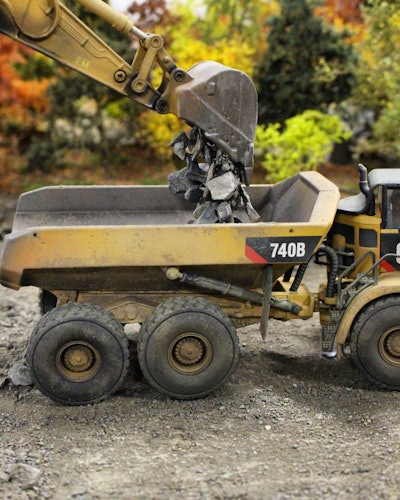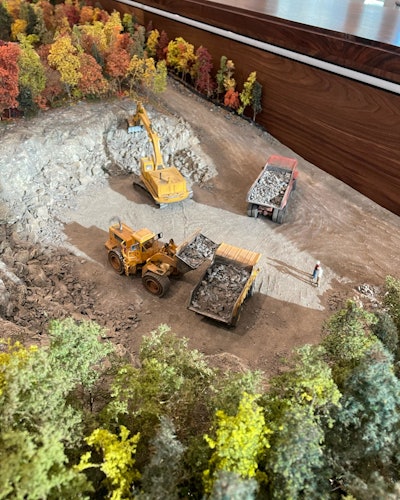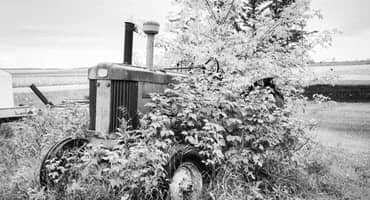Construction in Miniature: 26-Foot Diorama Tells Contractor’s 98-Year History
“It’s the largest one I've ever built,” says the project manager whose realistic dioramas of mini construction scenes have gone...

About three years ago, Ryan Haasen built a conference table for his family’s construction business that contained a diorama of construction jobsites.
After posting photos and videos of the project on LinkedIn, Instagram and other social media, floods of requests followed from contractors around the world asking if he could do the same for them.
“It blew up more than I ever would have expected,” Haasen says. “I'm talking like millions of views and thousands of likes and comments and shares.”
To Haasen, it was just a cool idea he had and decided to share with the construction industry and woodworking hobbyists. But his audience was amazed at the intricate details and his lifelike depictions of construction work.
Haasen spared no detail, using his construction experience to present lifelike scenes to scale, including customizing diecast models and realistic terrain. If you zoomed in with a camera close enough, people might think you were on an actual jobsite.
“I can take my industry knowledge and the artistic side and combine them together,” he says. “I know where to place the excavator and where to place a truck that is loading, and where to put the ladder in the ditch so it's safe, and how to slope the ditches and all these things.”
His work caught the eye of Herb Sargent, CEO of Sargent Corporation based in Bangor, Maine. He wanted a timeline diorama that could show the construction company’s 98-year evolution from horse and wagon to hydraulic excavators with GPS machine control and everything in between.
It would be a massive undertaking, especially for someone working only on the side while keeping a full-time construction job.
Haasen accepted the challenge, spending the next 10 months creating an intricate replica of construction sites through the decades. He even traveled to a museum in Bangor to take measurements for a model of a power shovel the company founder bought in 1930, and he read up on the company’s history to accurately depict its many stages of growth.
“He immersed himself in the actual story by reading that book,” Sargent says. “He even put some details in the diorama that I had forgotten about.”
Daydream in Action
 Ryan Haasen's first diorama table, built for his family's company, Blue-Con Excavating.Ryan Haasen
Ryan Haasen's first diorama table, built for his family's company, Blue-Con Excavating.Ryan Haasen
He started making wooden models of construction equipment at around age 13. In 2021, he was daydreaming while looking at a diecast excavator on his desk when he came up with the idea of making dioramas of construction scenes. He decided his first piece would be a conference table for Blue-Con.
He approached his father and boss, Matt Haasen, who wasn’t too excited about the idea. He didn’t understand what his son was talking about. After Ryan came back with some drawings of what he had in mind, his father relented but was still somewhat wary.
The result exceeded expectations.
“Every time we have a meeting with, say, a developer or client or whoever it might be, or an orientation with a new employee, it's in this conference room, and we sit down at this table, and their reaction is always cool to see,” Haasen says. “You can tell he's pretty proud to say, my son, Ryan, built this for us, and he works here.
“So that's pretty special.”
Sargent’s Vision
 A scene from a diorama table for DeKalb PipelineRyan Haasen
A scene from a diorama table for DeKalb PipelineRyan Haasen
Then came LinkedIn message from Herb Sargent.
“I was already aware of Sargent,” Haasen says. “I've seen some of the work they do and how the company operates, and I was already a fan from an industry perspective. And so when he reached out to me, I was over the moon and excited to build something for them.”
Over the next six months, Haasen and Sargent discussed Sargent’s vision for the diorama, what to put in and what to leave out. Along with visualizing Sargent’s ideas, Haasen studied the company’s history, including a detailed biography of the founder, Herb Sargent's grandfather and namesake.
“Between that and talking with Herb, we figured out what we could include in the table to tell that story,” Haasen says.
A Massive Diorama
 Notice the attention to detail in this scene for the Sargent diorama. Also note: the figure in the rowboat depicts company founder Herbert Sargent looking over a construction scene he did not live to see but would have been proud of.Ryan Haasen
Notice the attention to detail in this scene for the Sargent diorama. Also note: the figure in the rowboat depicts company founder Herbert Sargent looking over a construction scene he did not live to see but would have been proud of.Ryan Haasen
He would work 50 to 60 hours a week at Blue-Con and 30 to 40 hours on nights and weekends on the diorama.
He started with sections of high-quality plywood screwed together to form the diorama’s base. He sketched out the scenes with a Sharpie pen, transferring the design on paper to the wood.
He then cut the plywood into four sections and began building the terrain on each section using a variety of foam and plaster. Through it all, he had to keep in mind that it would all have to fit under a glass top.
“Then you start putting down a base layer of paint for the different types of terrain and then building up all that terrain, whether it be dirt or trees or grass,” he says.
While that’s going on, he’s also trying to acquire the diecast models. Some of the rarer models can cost as much as $1,200.
The diorama called for 30 pieces of equipment.
Some of the models didn’t exist, so he had to make them. One key machine was a 1927 Thew Model 00 power shovel the founder bought in 1930 for $6,000.
Haasen flew to Bangor and went with Sargent to the Cole Land Transportation Museum that now houses the shovel the company restored and donated. He took detailed measurements, created a 3D design and 3D-printed the model.
“It was a lot of work just for one single toy model, but it was a pretty important piece,” Haasen explains.
 The model Ryan Haasen created of a 1927 Thew 00 shovel is a 1:50 scale model of the real shovel Sargent founder Herbert Sargent bought in 1930.Ryan Haasen
The model Ryan Haasen created of a 1927 Thew 00 shovel is a 1:50 scale model of the real shovel Sargent founder Herbert Sargent bought in 1930.Ryan Haasen
“Tons of Smiles”
Haasen is a one-man show, for the most part. But when it came time to deliver the table, he got some help.
“At the end of the day, this thing packaged up into 11 different crates,” Haasen says. “Then my wife and I put it in a U-Haul, and we drove it across the country.”
They drove over 3,000 miles from Calgary to Bangor.
The fabrication team at Sargent had built a base for the table using excavator chains, track pads and steel beams. The Haasens showed up with the diorama as well as four large walnut slabs to form the outside of the table.
It took two days to assemble. When it was completed, everyone was amazed.
“A ton of smiles,” Haasen says of the reaction. “There were some tears because of the emotion that was conveyed in the model.”
Herb Sargent was amazed at the result.
“I was almost in tears,” he says. “It was such a kind of a heart-wrenching rendering of the company and its history, all the way to some of the things we've been able to achieve in the last few years.”
Sargent gave it as a gift to the company, which is 100% employee-owned.
“It's a great thing for us to have meetings around, but it's also when we have new employees come in,” he says. “We have their hard hats set up along that table, and that's where they kind of get introduced to the company. … They can all talk to each other about it and kind of learn a little bit more about what we are and how we got here.”
Completing the diorama table and seeing the reaction also gave Haasen a sense of fulfillment.
“You know that this company and the people there truly appreciated all the effort that went into it, and that makes it worthwhile.”
But he’s also going to stick to smaller projects for the foreseeable future. The long hours he spent on the Sargent diorama were not sustainable long-term. He also loves working for his family’s construction company and isn’t interested in creating dioramas full time, preferring instead to keep it a side hustle.
“It’s the largest one I've ever built,” he says, “and probably the largest one I will ever build.”
Construction in Miniature
Check out these photos of Haasen's work:
 Setting up Sargent's diorama conference tableRyan Haasen
Setting up Sargent's diorama conference tableRyan Haasen
 A scene form the pastRyan Haasen
A scene form the pastRyan Haasen
 Ryan Haasen spends lots of time searching for rare models for his dioramas, like this rare Euclid TC-12 dozer.Ryan Haasen
Ryan Haasen spends lots of time searching for rare models for his dioramas, like this rare Euclid TC-12 dozer.Ryan Haasen
 Ryan Haasen and Herb Sargent (standing) with the real 1927 Thew power shovel at the Cole Land Transportation Museum.Ryan Haasen
Ryan Haasen and Herb Sargent (standing) with the real 1927 Thew power shovel at the Cole Land Transportation Museum.Ryan Haasen


 Ryan Haasen
Ryan Haasen

 machineryasia
machineryasia 




